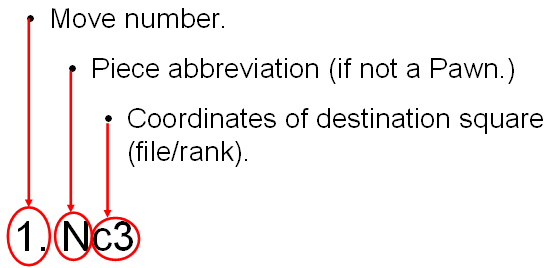The basics: | Piece Abbreviations: |
 |  |
The move number refers to White's move, so if you're writing down Black's move, just put a comma between White and Black's move like this:
1. Nc3, Nc6
If you don't have White's move written down, then add an ellipsis ("...") after the move number to show that White's move is omitted like this:
1... Nc6
Note: when using this site's chess playing software, do not enter the move number! |
The Pawn has no piece abbreviation. When a Pawn is moved, skip the piece abbreviation: just write down the destination square like this:
e4 |
If the move captures a piece, write an "x" between the piece abbreviation and the destination square like this:
10. Nxc3
If it's a Pawn capturing a piece, write down the starting file of the Pawn before the "x" like this:
10. exd5 |
When two of the same piece could move to the destination square, include either the file or rank of the starting square in order to make the move unambiguous. In the position on the right, both White Rooks could move to h5, and both Black Knights could move to c5. So we must write the starting file or rank (whichever makes the move unambiguous)
35. R1h5+, Nbc5
|

|
Kingside castling is written as: 0-0
Queenside castling is written as: 0-0-0
An easy way to remember this is to write down a zero for each square that the Rook moves when castling. |
Add these other symbols (shown on the right), as needed, to the end of the written move. For example:
40. exd8=R+ (Pawn on the e-file captures on d8, promoting to a Rook and delivering check.) |
 |



